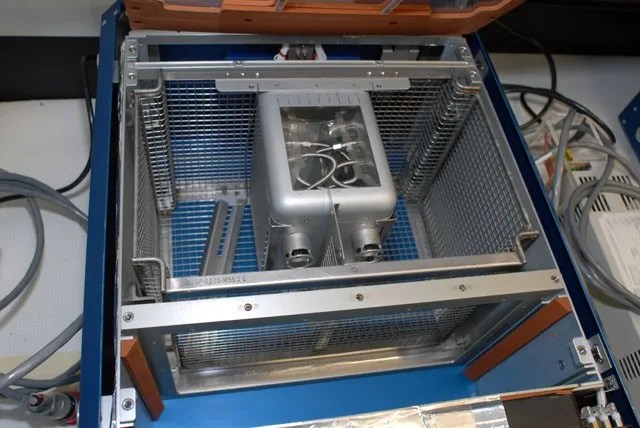Animal Biology Program
Hardware
Scientists and engineers at NASA developed specialized hardware and methods for simulating weightlessness in mice and rats. The method initially developed at NASA is now used worldwide to study adverse effects of disuse, inactivity, immobilization, and prolonged bed rest on earth. This hardware system allows rats or mice free movement around the cage, while removing weight bearing from the hindlimbs and shifting fluids towards the head, which astronauts also experience while in space.
Rodent Research Habitat
NASA's Rodent Research Hardware System provides a research platform aboard the ISS suitable for long-duration rodent experiments in space. The system has three major components: the transporter that safely transports rodents from Earth to the space station, the animal access unit that transfers the rodents upon arrival at the space station from the transporter into the habitat unit, and the habitat that provides long-term housing for rodents aboard the station.
For more information, visit the Rodent Research Habitat Fact Sheet
Fruit Fly Lab
NASA's Fruit Fly Lab provides a research platform aboard the International Space Station for long-duration fruit fly—Drosophila melanogaster—studies in space. The system has three major components. The first is the Fly Cassette that will house and safely transport fruit flies to the space station. The second is the Food Changeout Platform that will be used periodically to provide the flies with fresh food while maintaining containment and allowing extraction of fruit fly eggs, embryos, and larvae for preservation. The third is the Observation and Lighting System to allow fly behavior monitoring and exposure to an artificial day/night cycle.
Fruit Fly Lab FIT Cassettes
The Fruit Fly Lab FIT Cassette is designed to provide a habitat for fruit flies and, at the same time, safely transport fruit flies to the space station. Cassettes are installed in modified double-volume Type-I containers on the NanoRacks/Astrium centrifuge and on the NanoRacks microgravity rack.
Multipurpose Variable-G Platform (MVP)
Self-balancing centrifuges incorporated into the MVP enable researchers to perform microgravity experiments across a spectrum of gravitational conditions and on a wide variety of samples including cultured cells of Drosophila, Arabidopsis, and C. elegans.
Vented Fly Box (VFP)
The Vented Fly Box (VFB) platform houses 15 standard fly vials that contain flies and fly food. The VFB have mesh-covered vent holes that allow airflow to the samples and have clear windows on the sides to allow for evaluation. In addition, the VFB will also contain temperature/humidity data loggers inside the unit.





























